
The ancestry of “virtual reality” (VR), here used as a broad term encompassing various associated technologies such as “augmented reality” (AR), “mixed reality” (MR), “extended reality” (XR) etc., stretches back to the “stereoscope” of the nineteenth century. The figures below show a “Stereoscopic Daguerreotype Case” found in US patent 9611[i], dated March 8, 1853 – a kind of foldable 3D image viewer.
Over a century-and-a-half later, US patent application US2016349791A1[ii], filed in May 2016 and titled “Virtual Reality Headset And Device Case”, shows something bearing a resemblance to the above case, though it uses a smartphone as the source of the images seen by the viewer[iii] rather than Daguerreotypes – images formed by an old type of photographic process.
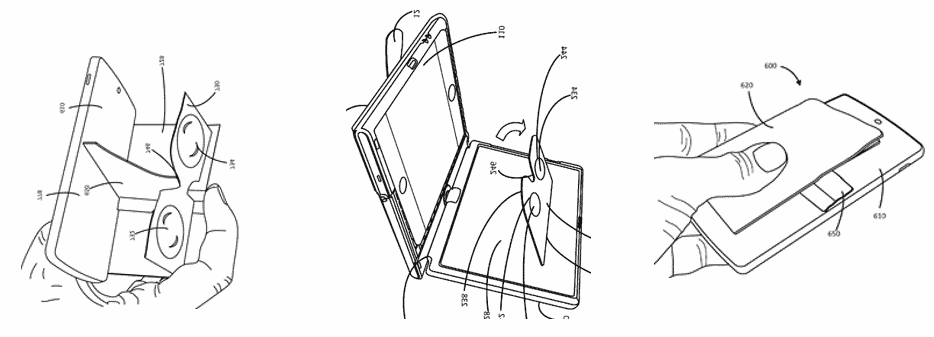
Nowadays, “virtual reality” may bring to mind hardware such as wearable headsets[iv] or glasses[v], as depicted below, along with an array of “virtual reality” applications, extending from video games to simulations of real-world activities, the use of “avatars”, and the rather elusive idea of “the metaverse”.

Recently, the term ‘metaverse’ has found its way into the headlines thanks to Meta (the parent company of Facebook) investing billions of dollars into its version of the aptly titled Metaverse, alongside reports of Apple looking to bring their own VR/AR headset to the market soon, with rumours suggesting that an announcement and showcase of their take on Virtual Reality could happen at their annual WWDC conference beginning on 5 June.
AR has also been made popular in recent times by the likes of Google Glass AR eyewear, and Microsoft’s HoloLens headset (which is currently being testing within the US military). With HTC continuing to bring their own Vive devices to market, consumers now have a great deal of options when it comes to picking up a new VR/AR device, and new players are emerging within the space regularly.
VR is sometimes a divisive topic, with some advocating for the complete replacement of physical work environments with virtual office spaces, and with some dismissing the technology after trying it for themselves due to complaints of motion sickness and headaches during use. Love it or loathe it, VR has existed in some form for over 150 years already and shows no signs of disappearing anytime soon.
Feeling Trendy
As the popularity and number of applications of VR/AR devices continues to increase, it may come as no surprise that similar trends may be observed with respect to the number of related patent applications filed in recent years.
In an attempt to identify worldwide patent application families, and applicants showing an interest in virtual reality – not just in terms of hardware, but also the potential uses of VR – a query using VR related keywords in the titles, abstracts or claims of patent applications was applied to the Espacenet database, which covers around 100 countries[vi].
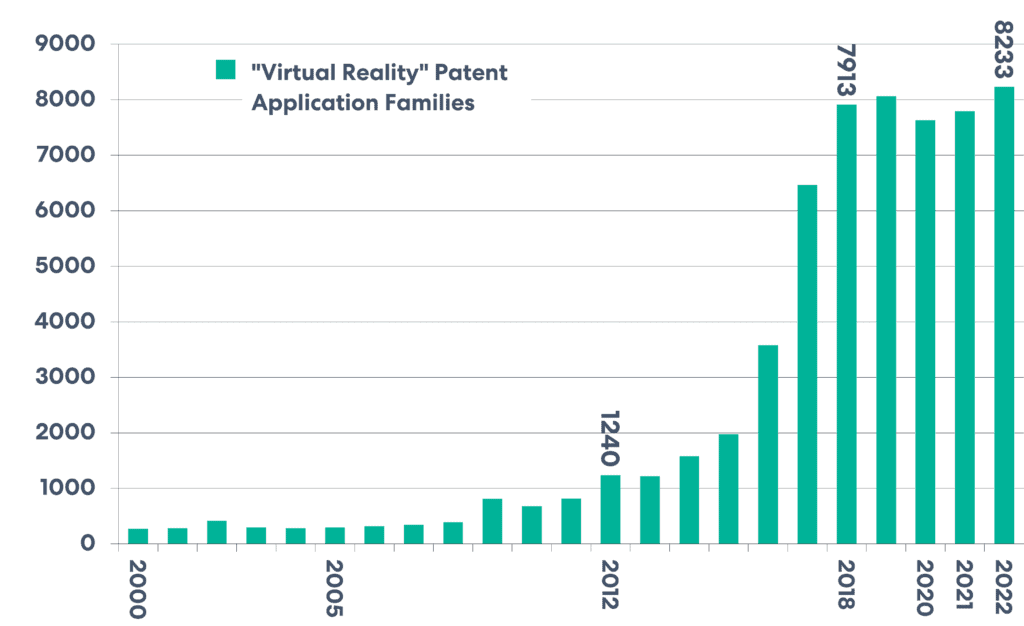
The numbers of new VR related patent application families increased rapidly from around 2015 to 2018, although some part of the increase may simply reflect an increase in the usage of relevant terminology (e.g., “virtual reality” etc.) over time. Since 2018, the number of new VR related patent application families appearing each year seems to have settled at something of a plateau, but the number has not declined by a substantial amount.
The numbers of Espacenet patent application families associated with particular applicants can only be estimated, since counting the number of families depends on e.g., how families belonging to related but legally distinct companies are handled, how families belonging to joint applicants are counted and, particularly, how translations or transliterations of names and variations in naming of applicants are handled. That said, the table below indicates the estimated top applicants in terms of their numbers of new VR families appearing from 2020 to 2022. These top applicants accounted for just over 20% of all new VR families from 2020 to 2022.
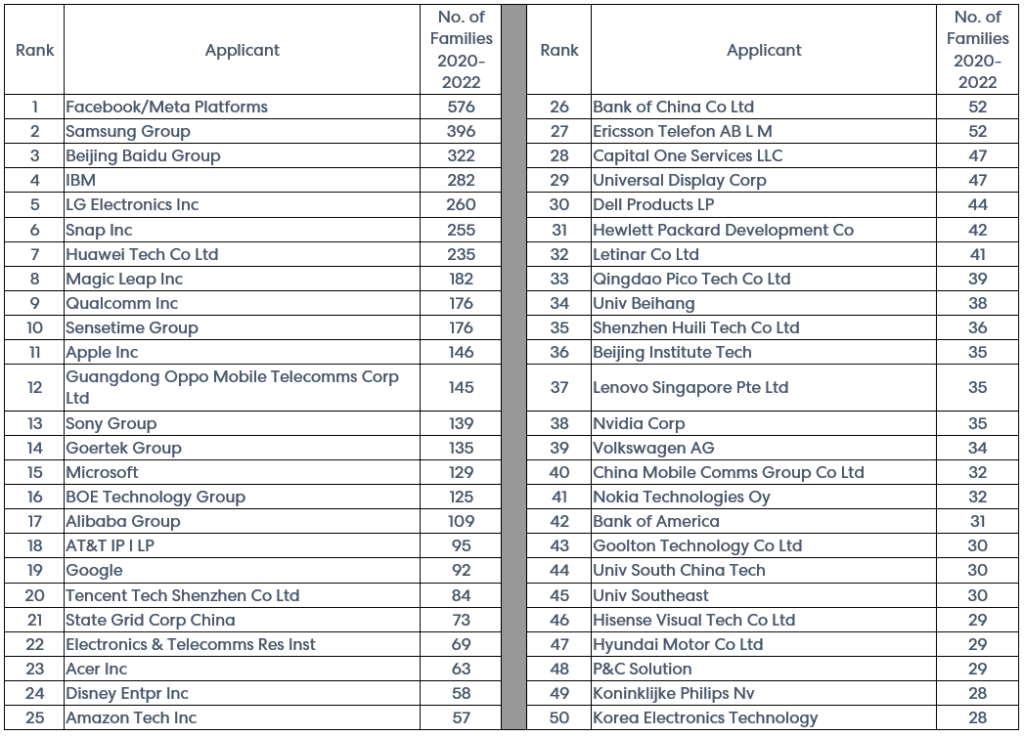
Perhaps unsurprisingly, Meta, with their substantial investments into the VR space in recent years, appears at the top of this list. Snap, owners of the photo-based messaging application Snapchat, and famous for their take on wearable technology in the form of Snapchat Spectacles (a pair of fashion-statement camera-equipped sunglasses which have evolved into AR-equipped eyewear), appear sixth on the list.
It is clear from the table below that companies from a broad range of sectors have an interest in developments to VR, including the likes of banks and automotive manufacturers.
A Leap Forward
Focusing on European patent (EP) applications concerned with developments to virtual reality, a query using VR related keywords in their titles, abstracts or claims was directed to the EPO’s “EP full-text search” database[vii].
The numbers of VR European applications published each year increased rapidly up to 2020. First exceeding 100 published EP applications in one year in 2012, the number grew year on year to reach almost 1000 published EP applications in 2020. In 2021 and 2022, the numbers of published applications fell slightly short of the number in 2020, where growth seems to have now stalled.

According to the keyword query of the EPO’s “EP full-text search” database, the most active companies and institutions, in terms of the total number of VR European applications published from 2020 to 2022, are shown in the table below. The companies and institutions listed account for nearly 50% of all VR European applications published, according to this keyword query.
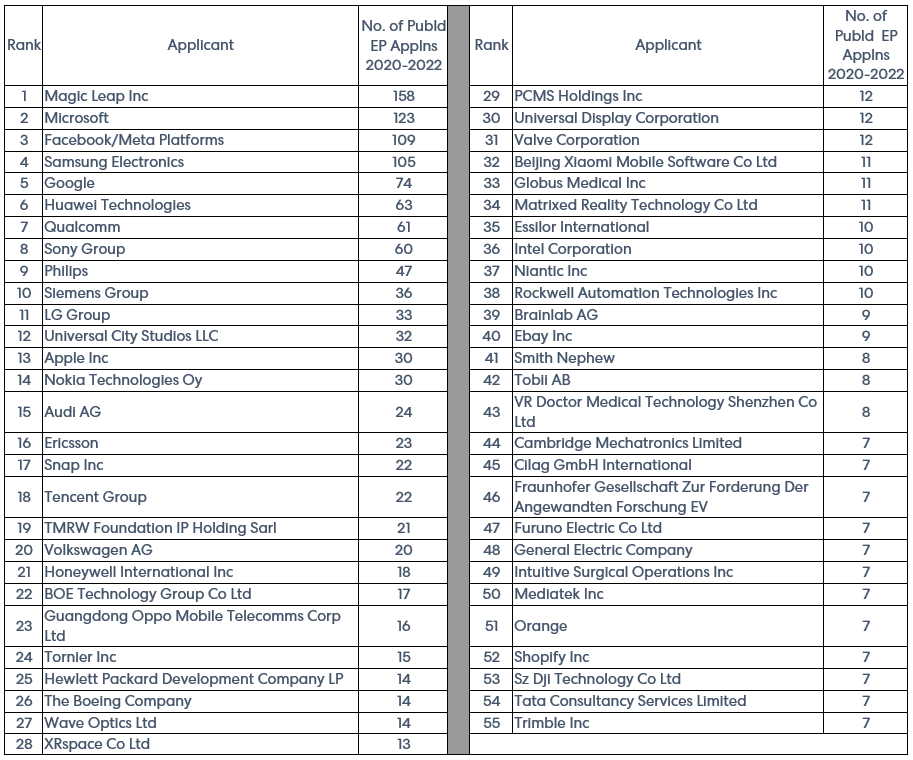
Magic Leap, an American technology company providing AR business solutions in the form of IT tools and services, alongside their own hardware device, the Magic Leap 2, appears at the top of the list, followed by Microsoft and Meta.
A similar VR keyword query of the EPO’s “EP full-text search” database[viii] indicates that the numbers of “virtual reality” EP patents granted began to increase from around 2016 to 2018, following on from the rise in published EP applications, as might be expected.
According to the above keyword query, the patentees with the most EP patents granted are shown in the table below. The listed patentees account for around 60% of all “virtual reality” EP patents so far granted.
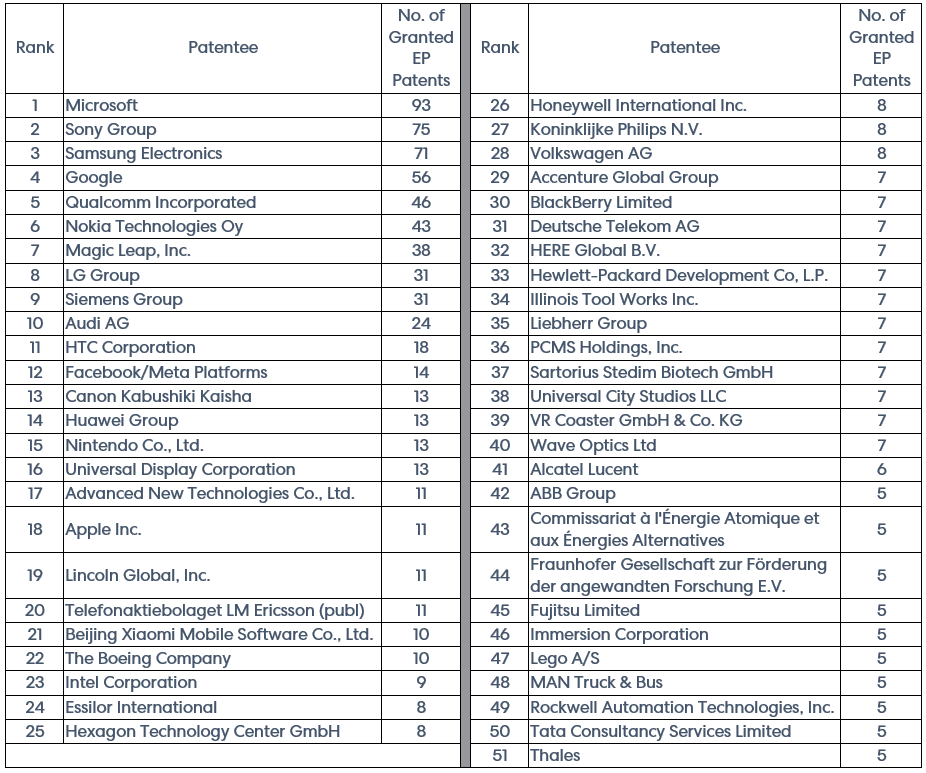
Similar trends to those already discussed can be seen from the below graphs, showing rapid increases in number of patents granted year by year between 2015 and 2021, as well as an almost exponential increase in the cumulative number of VR patents granted to date.
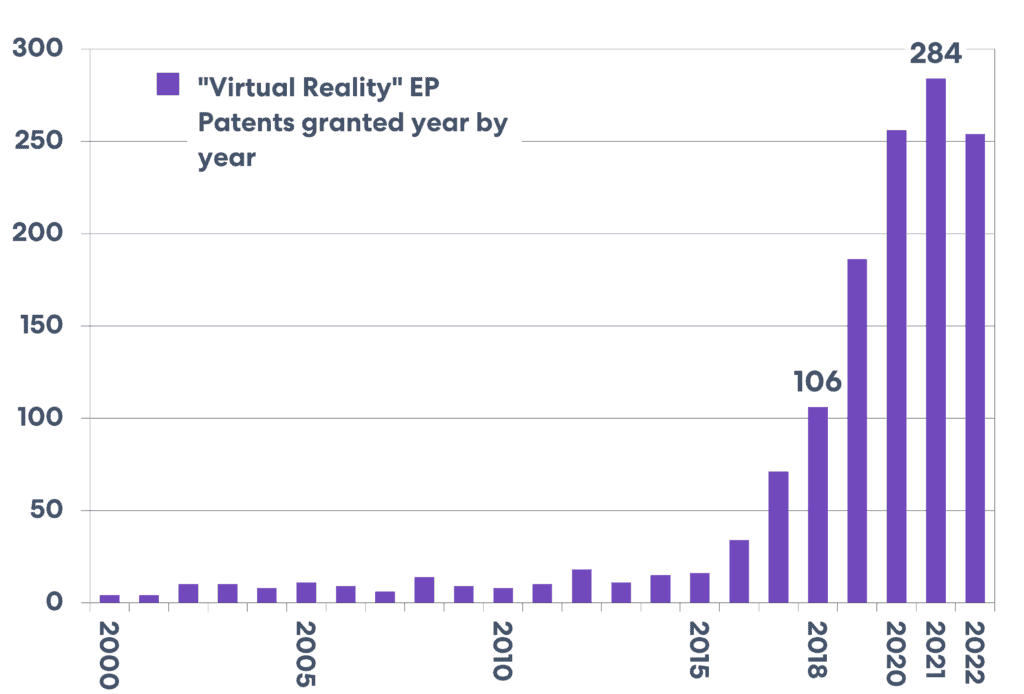
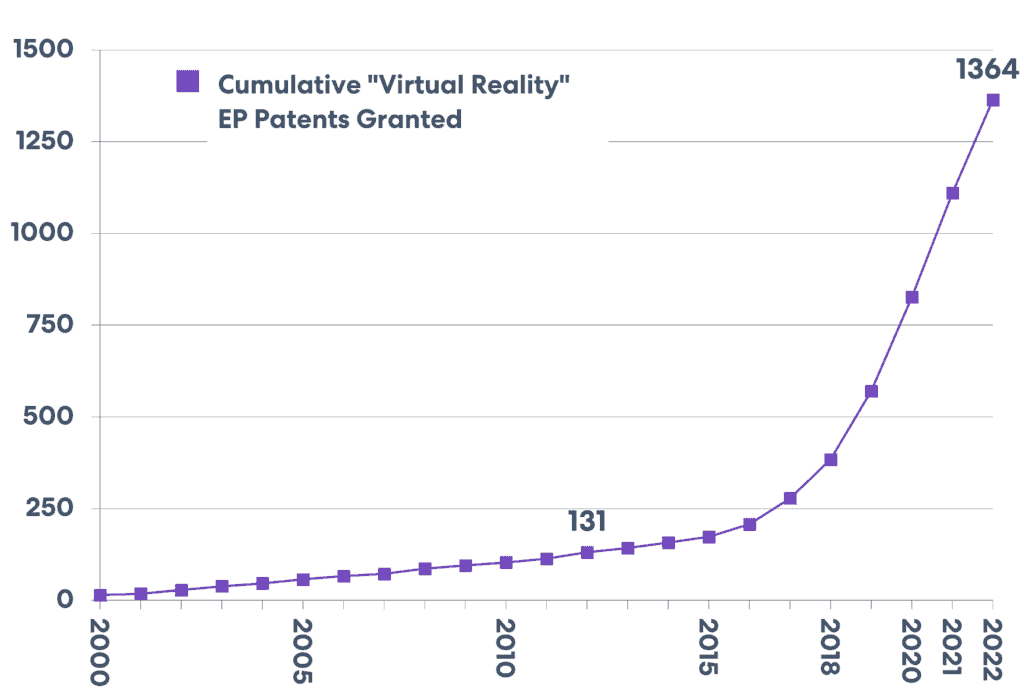
IP Address
As well as the numbers of patent applications, the countries of origin of inventions/developments related to VR can indicate where VR is being spearheaded. Generally, an indicator of origin is the country in which the priority founding application of the patent family was filed. The USA is by far the most frequent priority country of VR European patent applications, however, since 2016, China has been by far the most frequent priority country of worldwide VR patent applications. It appears that a period of strong growth in the numbers of VR applications and families from around 2015 was observed worldwide, in both China and the US, as well as other countries.
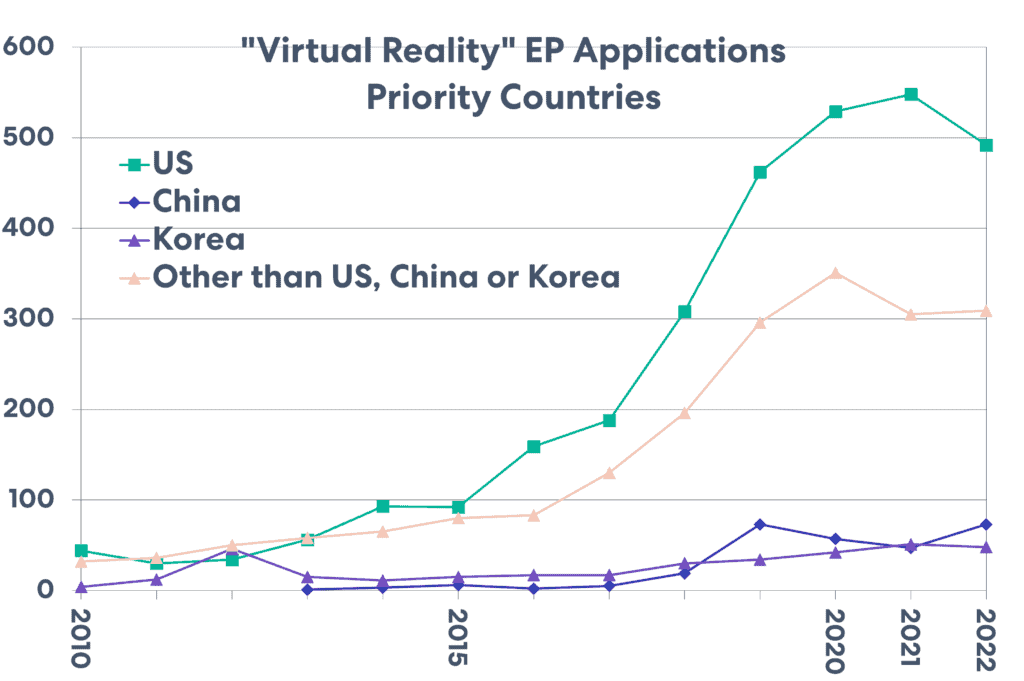
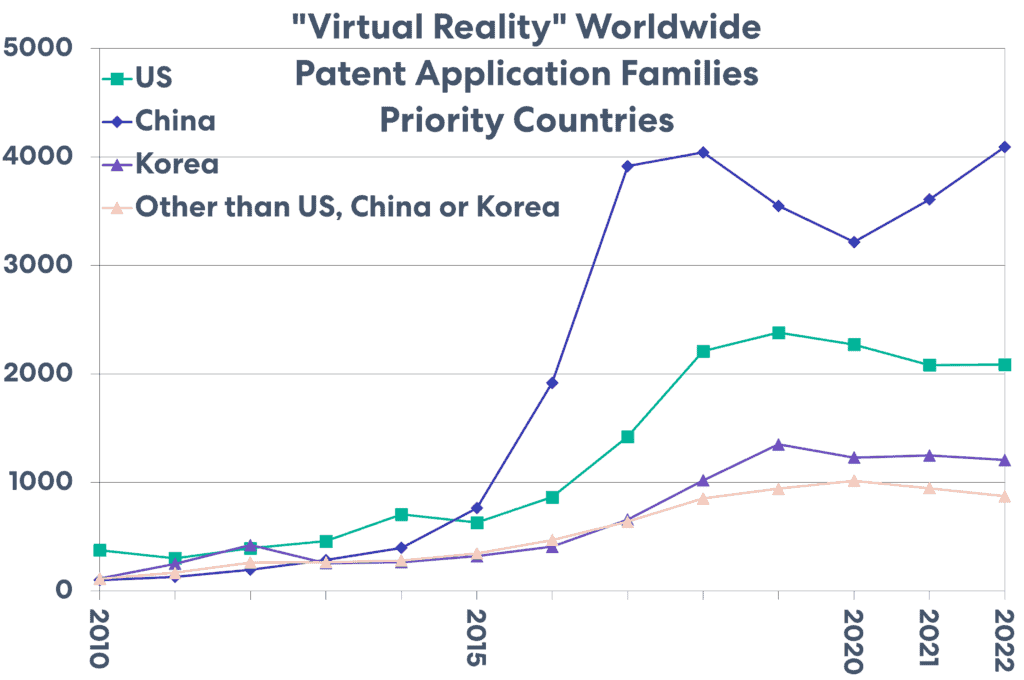
As may be seen from the tables above, VR is a popular area of development in a huge range of different business sectors. Aside from the marketing of VR headsets or glasses by big names in personal computing, the range of different fields of activity of applicants of EP applications and worldwide patent families is also noteworthy. The table below gives some examples of these applicants, with fields of activity ranging from defence to amusement parks.
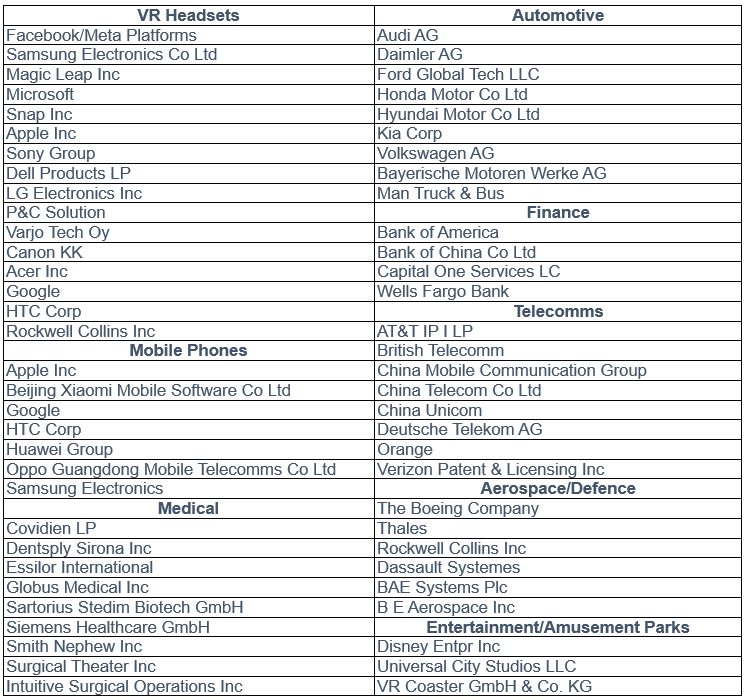
It is clear that the applications of VR (as well as other forms of enhanced reality) are vast. With existing solutions already providing us with turn-by-turn directions on our car windscreens and allowing us to step into the shoes of popular video game characters, and with emerging applications in medicine and defence, VR only looks to be getting started.
References
[i] https://worldwide.espacenet.com/patent/search/family/002069930/publication/US9611A?q=US9611A
[ii] https://worldwide.espacenet.com/patent/search/family/056108726/publication/US2016349791A1?q=US2016349791A1
[iii] e.g. images provided by Google Cardboard Apps; https://arvr.google.com/cardboard/apps/
[iv] See USD785619S, May 2, 2017, “3D Virtual reality headset design”; https://worldwide.espacenet.com/patent/search/family/058629331/publication/USD785619S?q=USD785619S
[v] See USD795952S, August 29, 2017, “Virtual reality glasses”; https://worldwide.espacenet.com/patent/search/family/059654847/publication/USD795952S?q=USD795952S
[vi] Espacenet can be accessed at:- “https://worldwide.espacenet.com/”.
The countries covered by the Espacenet database can be seen at:- https://www.epo.org/searching-for-patents/technical/patent-additions.html
The query used was:- “ctxt=(“virtual” prox/distance<1 “reality”) OR ctxt=(“augmented” prox/distance<1 “reality”) OR ctxt=(“extended” prox/distance<1 “reality”) OR ctxt=(“mixed” prox/distance<1 “reality”) OR ctxt=(“enhanced” prox/distance<1 “reality”) OR ctxt=(“artificial” prox/distance<1 “reality”) OR ctxt=(“artificial” prox/distance<1 “reality”) OR ctxt=(“virtual” prox/distance<1 “world”) OR ctxt=(“augmented” prox/distance<1 “world”) OR ctxt=(“extended” prox/distance<1 “world”) OR ctxt=(“mixed” prox/distance<1 “world”) OR ctxt=(“enhanced” prox/distance<1 “world”) OR ctxt=(“artificial” prox/distance<1 “world”) OR ctxt=(“artificial” prox/distance<1 “world”) OR ctxt=(“virtual” prox/distance<1 “universe”) OR ctxt=(“augmented” prox/distance<1 “universe”) OR ctxt=(“extended” prox/distance<1 “universe”) OR ctxt=(“mixed” prox/distance<1 “universe”) OR ctxt=(“enhanced” prox/distance<1 “universe”) OR ctxt=(“artificial” prox/distance<1 “universe”) OR ctxt=(“artificial” prox/distance<1 “universe”)”
[vii] The EPO’s “EP full-text search” database can be accessed via:-
https://www.epo.org/searching-for-patents/technical/ep-full-text.html
The query used was:- “(CLEN or ABEN or TIEN or CLDE or ABDE or TIDE or CLFR or ABFR or TIFR) = (augmented* or extended* or mixed* or enhanced* or artificial* or virtual*) +1w (realit* or world* or universe*) or (CLDE or ABDE or TIDE) = (erweitert* or gemischt* or künstlich* or virtuell*) +1w (realit* or welt* or univers*) or (CLFR or ABFR or TIFR) = (réalit* or monde* or univers*)+1w (augmenté* or virtuell* or étendu* or artificiell*) and (PUK=A1 or PUK=A2)”
[viii] The query used was:- “(CLEN or ABEN or TIEN or CLDE or ABDE or TIDE or CLFR or ABFR or TIFR) = (augmented* or extended* or mixed* or enhanced* or artificial* or virtual*) +1w (realit* or world* or universe*) or (CLDE or ABDE or TIDE) = (erweitert* or gemischt* or künstlich* or virtuell*) +1w (realit* or welt* or univers*) or (CLFR or ABFR or TIFR) = (réalit* or monde* or univers*)+1w (augmenté* or virtuell* or étendu* or artificiell*) and (PUK=B1)”
This is for general information only and does not constitute legal advice. Should you require advice on this or any other topic then please contact hlk@hlk-ip.com or your usual HLK advisor.

